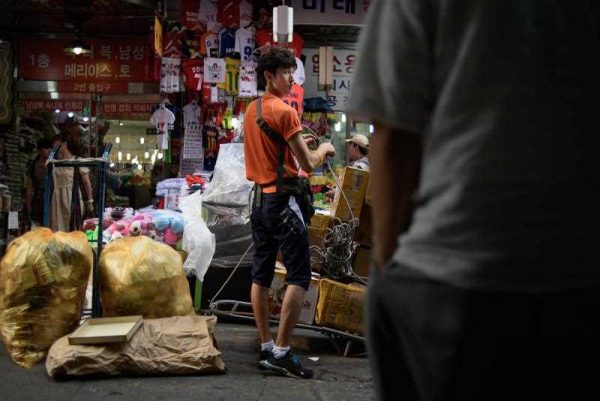These facts suggest that since then, South Korea’s economic growth has been entirely driven by the export sector.
Growth in exports has been high for the past 30 years, on average more than 10 per cent per year, confirming the widespread view that exports underpin South Korea’s economic growth. More importantly, the contribution of exports to GDP growth has not changed much since 1980. The five-year average of the contribution of exports to GDP was 3.9 percentage points from 1991–95, 3.6 percentage points during 2001–05 and 3.8 percentage points during 2006–10. This indicates that the slowdown in both GDP growth and domestic demand growth is because the spillover effects from the export sector have dampened. Why has this happened?
A clue lies in the proportion of domestic value-added components of exports, which has been trending downwards from around 76 per cent in 1995 to roughly 60 per cent in 2009. This suggests that the contribution of South Korean export firms to domestic production has declined because those firms have been typically outsourcing to foreign supply chains. This phenomenon is not limited to South Korea. Most OECD member countries have reported decreasing proportions of domestic value-added components since the mid-1990s, a result of the widespread use of global value chains. If domestic export firms extensively use global value chains, the contribution of domestic value-added components to gross exports is likely to drop.
But the decrease in the proportion of domestic value-added components of exports in South Korea is also related to some other factors, distinguishable from other OECD members, which significantly decrease the spillover effects of export growth.
First, there has been a substantial decline in the contribution of small and medium-sized enterprises (SMEs) to exports, relative to large-sized firms. This downward trend is a result of the relative labour productivity of each firm size. The ratio of value added per worker in SMEs to those in large-sized firms during 2002–06 was around 39.4 per cent, further decreasing to around 34.5 per cent during 2007–10. This implies that large-sized South Korean exporting firms purchase foreign intermediate inputs for their final export goods due to the low productivity of local SMEs.
Second, the relative labour productivity of the service sector to the manufacturing sector has been declining, from 62 per cent in 2002 to 47 per cent in 2012. In addition, the service value-added components of manufacturing exports are much lower in South Korea than the rest of the OECD. This lower productivity means firms in the service sector fail to exploit the benefits from engaging in global value chains, which in turn dampens the spillover effects from large-sized firms’ exports.
The share of the service sector in total employment has been growing, from 62.3 per cent in 1993 to 74.1 per cent in 2012. SMEs account for about 80 per cent of output and 90 per cent of employment in the service sector. This suggests that the productivity gap between the two sectors is closely linked to the productivity gap between SMEs and large-sized firms.
The reason for this relative productivity gap between SMEs and large firms can be found in the structural problems of the South Korean economy. After the Asian financial crisis, large-sized firms restructured, shedding labour and investing abroad, in order to regain competitiveness. But SMEs fell behind. And the regulatory environment discouraged the growth of new industries and the service sector.
Labour market segmentation due to the widespread use of temporary contracts may have negatively affected firms’ total factor productivity (TFP). One reason could be that as permanent workers become more costly to terminate, firms are less likely to convert temporary workers to permanent ones and are more likely to reduce investment in on-the-job-training for temporary workers. Knowing this, temporary workers tend to make less of an effort. This will decrease a firm’s TFP (which combines the productivity of both temporary and permanent workers). Because the share of temporary workers is larger in SMEs than in larger firms, the labour market segmentation may also contribute to the productivity gap.
These structural problems have curtailed any positive spillover effects from export growth — mainly driven by large-sized firms — across key dimensions of the South Korean economy. Although large-sized firms have substantially increased their sales in foreign markets, they have also substantially increased their usage of foreign components. This, and the productivity gap between SMEs and large-sized firms, exposes the economy’s inherent weaknesses. Future policymakers must overcome this challenge in order to ensure continued and equitable growth across the economy.
Seongman Moon is a research fellow at the Korean Institute for International Economic Policy (KIEP). The views expressed in this article are those of the author and do not necessarily represent those of the KIEP or KIEP policy.


Sounds like South Korea is making the same mistake that the USA is doing by sending its manufacturing base overseas and thinking that retail and service industries will compensate for the loss of the revenue and manufacturing jobs.
In addition to outsourcing its manufacturing base S Korea is also increasing its reliance on temporary workers. These folks are generally paid less and have less job security. Thus, they have less disposable income as well as are less inclined to spend what they have out of concern for their future. Meanwhile the upper level execs and families which own SK’s large industries are pocketing their increasing incomes. The seeds of a vicious, negative cycle are already in place. Will the government take steps needed to change these dynamics? Do the politicians of SK have the courage to confront these powerful forces in the country?!?